| May 1968 Popular Mechanics |
 [Table
of Contents] [Table
of Contents]
Wax nostalgic over early technology. See articles from
Popular Mechanics, published 1902 - 2021. All copyrights are hereby acknowledged. |
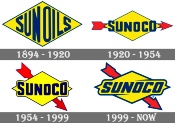 This "Product Feature: Octane" pamphlet
was an insert in the May 1968 issue of Popular Mechanics magazine. As the
subtitle claims, it summarizes "What it is, What it does, How to get your money's
worth." Truth is it is really an infomercial from the
Sun Oil Company (aka
Sunoco), but there is some useful information about how octane levels affect engine
performance. Back in the days before computers ran car engines, various factors
like temperature rating of spark plugs, compressions ratio, condenser and ignition
coil condition, timing (before top-dead-center, BTDC), ambient air temperature and
humidity, altitude, and other factors made using the right blend of gasoline necessary
to get top performance. Today's computers measure, monitor, and compensate for a
lot of that, so most engines can run on just about any gasoline. An exception is
high compression ration engines in expensive sports cars requiring high octane levels.
As an aside, the current (2023) Sunoco logo is my favorite of the four
historical logos. It looks very retro. This "Product Feature: Octane" pamphlet
was an insert in the May 1968 issue of Popular Mechanics magazine. As the
subtitle claims, it summarizes "What it is, What it does, How to get your money's
worth." Truth is it is really an infomercial from the
Sun Oil Company (aka
Sunoco), but there is some useful information about how octane levels affect engine
performance. Back in the days before computers ran car engines, various factors
like temperature rating of spark plugs, compressions ratio, condenser and ignition
coil condition, timing (before top-dead-center, BTDC), ambient air temperature and
humidity, altitude, and other factors made using the right blend of gasoline necessary
to get top performance. Today's computers measure, monitor, and compensate for a
lot of that, so most engines can run on just about any gasoline. An exception is
high compression ration engines in expensive sports cars requiring high octane levels.
As an aside, the current (2023) Sunoco logo is my favorite of the four
historical logos. It looks very retro.
Octane: What it is, What it does, How to get your money's worth
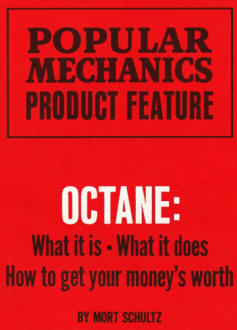 By Mort Schultz By Mort Schultz
Once and for all, let's set the record straight about octane.
Important? You bet. When you buy premium or regular grade gasoline, you're buying
octane - either high or low. But buying too much octane wastes money. Buying too
little octane will give poor engine performance.
Here, then, are the facts about this important, but not too often understood
subject.
Octane is a Measurement - Not an Additive
Octane is not a physical property of gasoline. Instead, it's a rating of a gasoline's
ability to resist power-robbing detonation or "knock" in an engine's combustion
chamber. Octane rating is accepted as a standard method of measurement and comparison
by all manufacturers of gasoline and automobiles.
Every engine has a different octane requirement!
Octane Rating Should Meet Your Engine's Needs
Why? Because as a piston compresses the fuel mixture in a cylinder that mixture
gets hot. The more it's compressed, the hotter it gets. If gasoline is too low in
octane rating for the engine, heat of compression could spontaneously ignite the
mixture before the spark plug fires. This detonation causes a sudden, extreme rise
in pressure which you hear as knock and feel as loss of power.
The result is just the opposite when your engine uses a gasoline with the octane
rating it needs. The mixture is ignited at the proper time by the spark plug. You
get all the power the engine's built to deliver - smoothly, efficiently.
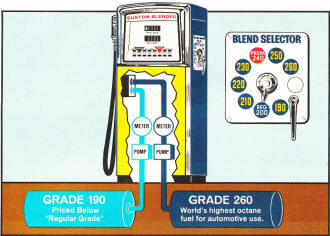
How Sunoco gives you a choice of 8 different octane gasolines.
Sunoco's unique Custom Blending system works very simply. The
Blend Selector on the side of the pump is set for the one of eight custom blends
that is just right for your car. This precisely controls the proportions drawn from
each of two buried tanks. One tank contains Sunoco 190, a lower-octane, less expensive
gasoline. The other contains Sunoco 260, the highest octane pump-grade gas you can
buy. Inside the pump body, metering and pumping controls accurately pump, mix and
deliver the Custom Blend that is exactly right for your car.
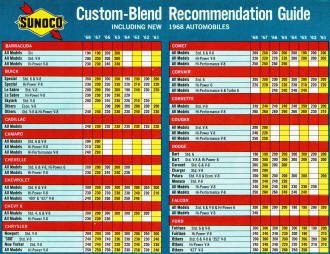
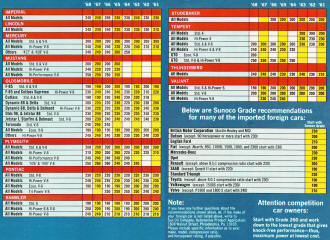
What does this mean to you? Obviously, that the gasoline you use must be of an
octane rating which your car needs. It could be low octane or high octane. That
depends on the engine.
Unfortunately, many people buy too much octane. This is a throw-back to the late
1950's when approximately half of the cars manufactured needed high octane gas for
their high compression engines. In those days, the alternative would have been detonation
and millions of knocking engines.
This is no longer true. Almost 67 percent of today's new cars are designed to
run on low octane (regular) gas. Those who use high octane (premium) unnecessarily
are spending 4¢, 5¢, even 6¢ a gallon more for no reason. The high octane is not
giving their engines anything that lower octane gasoline can't give them.
As we've noted, an engine that requires high octane gasoline should not be operated
on low octane gas. Detonation is the result.
So, how do you pinpoint the octane rating your engine needs? It's easy!
How to Select the Right Octane
1. Tune your engine to manufacturer's specification, making
sure that ignition timing is on the nose. This will get you the mechanical efficiency
intended by the manufacturer and will also bring you within range of his recommendation
for grade of gasoline. But be careful. Here's where many people misinterpret the
manufacturer's recommendation for "premium" or "regular" gas.
Variations in engine tolerances, differences in the way engines are adjusted,
and even individual driving habits result in different octane requirements for engines
that are identical in year, make and model. Even when properly tuned, these engines
can differ in their needs by several octane numbers. A manufacturer's recommendation,
then, is a guide only.
2. Select the major brand of gasoline that offers the widest
choice of octane ratings. Obviously, you have a better chance of meeting your engine's
octane needs if you can choose from several octane ratings rather than from the
two or three which most stations offer. Of the major brands, Sunoco offers the widest
choice-eight octane levels, about a penny apart in price.
3. Don't be misled by claims of additives. Virtually every major
brand of "premium" gasoline and some "regular" brands contain additives to prevent
corrosion, carburetor icing, dirty carburetors and cylinder deposits. Don't buy
a "premium" gas just to get extra additives. Both the fuel and automotive industries
agree that you gain riothing by using a "premium" fuel in a properly tuned engine
which is designed to run on "regular".
4. Once you've decided on "regular" or "premium," try a tankful.
If you get good performance, switch to a lower-octane rated, less expensive grade.
If the engine still operates efficiently without knocking, there's no need to use
the higher grade. If you try "regular," however, and hear a knock and suffer poor
performance, move up in octane level until the knock disappears.
In any event, what you're doing is carefully customizing gasoline to your engine's
needs for peak efficiency and performance at the lowest possible cost.
Posted September 4, 2023
|














